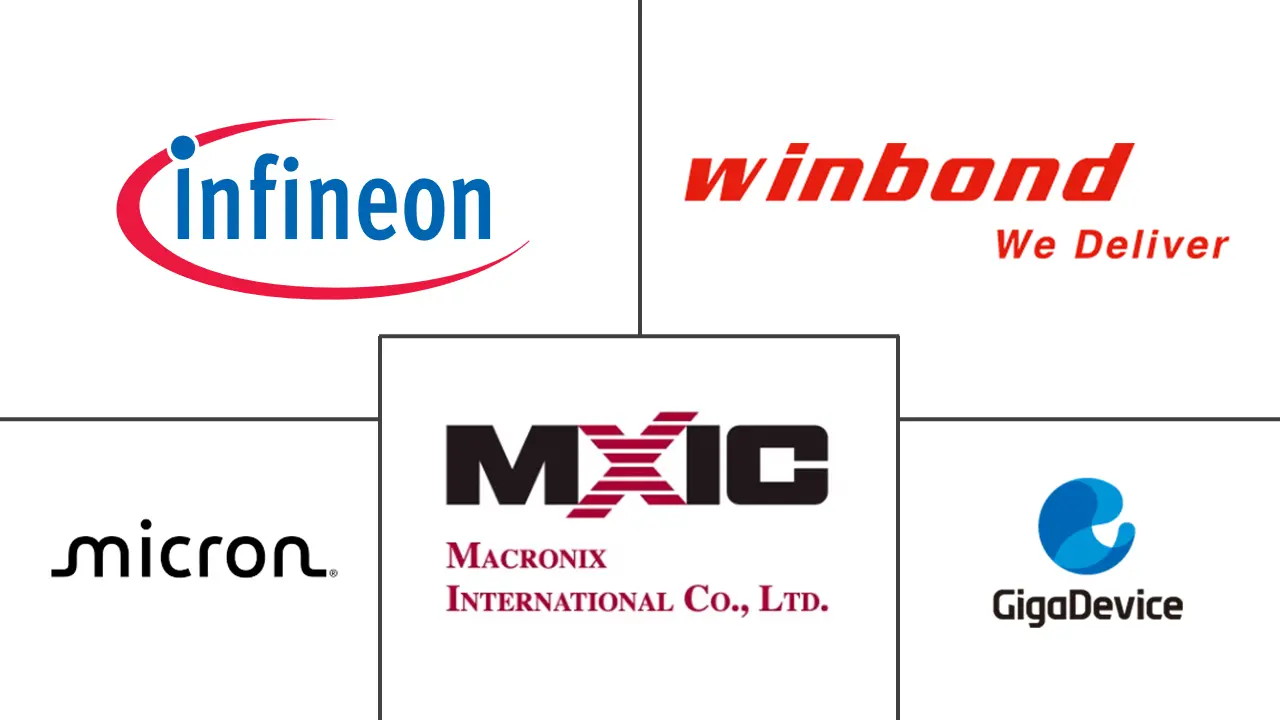India NOR Flash Market Size and Share
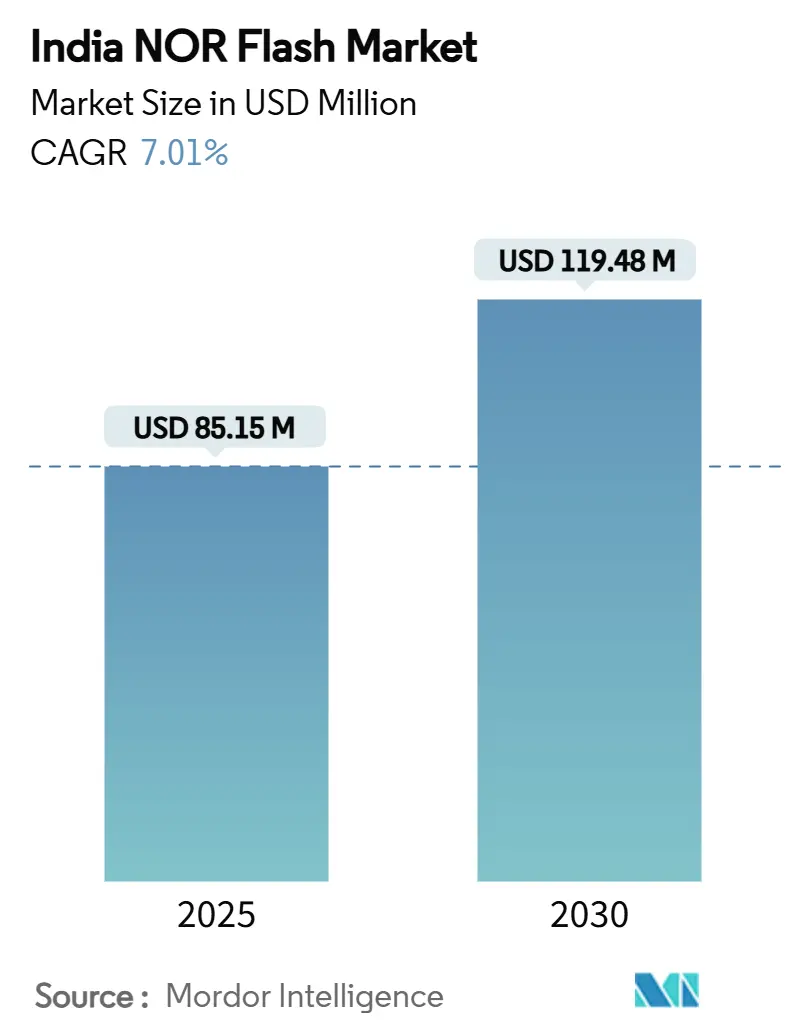
India NOR Flash Market Analysis by Mordor Intelligence
The India NOR Flash Market size is estimated at USD 85.15 million in 2025, and is expected to reach USD 119.48 million by 2030, at a CAGR of 7.01% during the forecast period. Domestic electronics manufacturers are increasingly transforming imports, such as smartphones, automotive ECUs, and industrial IoT nodes, into indigenous production. This transition significantly enhances baseline unit demand while enabling manufacturers to allocate fixed overheads across larger production volumes. Furthermore, Continued policy support under the Semicon India Programme, worth INR 76,000 crore (USD 9.2 billion), anchors domestic fabrication plans and underpins resilient demand for secure code-storage solutions in automotive, industrial, and connectivity devices[1]Source: Press Information Bureau, “Union Cabinet approves Semicon India Programme,” pib.gov.in. Consequently, these incentives encourage additional investments in test automation and wafer-level packaging technologies. In parallel, the Bureau of Indian Standards' secure-boot regulations mandate the adoption of higher-density devices with embedded encryption. This requirement increases the dollar content per board and secures long-term design commitments. Additionally, automotive Tier-1 suppliers have already entered into multi-year contracts for AEC-Q100-qualified components, while handset manufacturers continue to procure low-density devices for RF front-end modules. These developments collectively ensure a stable volume floor for production. Altogether, these overlapping factors positively impact the India NOR Flash Market by reinforcing economies of scale, driving fresh capacity expansions, and creating opportunities for new entrants. Companies that focus on localized backend services are particularly well-positioned to gain market share in this evolving landscape.
Key Report Takeaways
- By type, Serial NOR Flash led with 86% of India NOR flash market share in 2024; the segment is projected to expand at a 7.10% CAGR through 2030.
- By interface, Quad SPI held a 55% share in 2024, driven by its compatibility and cost-effectiveness. Meanwhile, Octal and xSPI is forecast to grow at a 7.14% CAGR through 2030, driven by demand for high-bandwidth applications.
- By density, 32 Mbit accounted for a 24% share in 2024, while the ≥256 Mbit segment is set to grow at a 7.21% CAGR, driven by demand for advanced applications like dashboard controllers and camera fusion modules.
- By voltage, 3V devices held a 63% share in 2024, while 1.8V devices are forecast to grow at a 7.09% CAGR, driven by demand for better battery life in devices like sensor nodes and wearables.
- By end-user, consumer electronics generated 35% of revenue in 2024, driven by high-volume production in India. Meanwhile, the automotive sector is poised for growth, fueled by a 7.22% CAGR in ADAS ECU content.
- By process technology node, 65 nm accounted for 32% of 2024 revenue, driven by reliable yields and lower capex. The 28 nm and smaller segment is set to grow rapidly with a 7.12% CAGR.
- By package type, QFN/SOIC accounted for 47.1% share, whereas WLCSP/CSP is poised for growth, driven by a 7.11% CAGR.
India NOR Flash Market Trends and Insights
Drivers Impact Analysis
| Driver | Impact | Geographic Relevance | Impact Timeline |
|---|---|---|---|
| PLI and Semicon India subsidies | +3.2% | Pan-India | Short term (≤ 2 years) |
| Secure-boot mandate for IoT devices (IS17428) | +2.8% | Pan-India | Medium term (2–4 years) |
| Automotive ADAS ECU boom | +2.4% | Western and Southern clusters | Long term (≥ 4 years) |
| Smartphone Make-in-India scale-up | +1.8% | Northern and Southern clusters | Long term (≥ 4 years) |
| Source: Mordor Intelligence | |||
PLI and Semicon India subsidies covering up to 50% CapEx for memory packaging lines
Under the PLI and Semicon India funding programs, new assembly, testing, and advanced packaging lines are eligible for a reimbursement of 50% on their capital outlay. Consequently, this incentive has encouraged domestic module houses and foundry partners to establish their capacities onshore, thereby significantly strengthening the India NOR flash market. For instance, Sahasra’s new OSAT facility in Rajasthan and Micron’s backend operation in Gujarat are achieving breakeven at an accelerated pace. As a result, both companies are able to offer lower average selling prices, effectively passing on the cost savings to downstream stakeholders. Moreover, these subsidies also support investments in robotics, precision tooling, and inline metrology. This, in turn, enhances volume yield and facilitates the transition to sub-28 nm technologies. As these production lines scale up, the resulting increase in domestic output reduces foreign-exchange leakage. Furthermore, it reinforces the resilience of local supply chains, which is critical for sustaining the growth and competitiveness of the India NOR flash market.
Mandatory secure-boot guidelines in Bureau of Indian Standards IS17428 for IoT devices
The Bureau of Indian Standards mandates that every consumer IoT node must now feature a cryptographically verifiable boot chain. Consequently, this directive compels designers to adopt Quad- or Octal-SPI NOR components, which are equipped with on-chip encryption, secure key storage, and advanced error-correction engines. Furthermore, suppliers such as Winbond, Macronix, and Infineon have already secured local qualifications. However, Tier-2 EMS firms are currently facing a 20-week backlog for the 128 Mbit secure NOR. In addition, as battery-operated sensors predominantly require 1.8 V options, the range of compliant products has shifted away from the legacy 3 V sockets. The larger die area necessitated by these security-enhanced components increases the dollar content per device. Consequently, this development is driving an uplift in the blended average selling prices (ASPs) within the India NOR flash market. Overall, these changes are expected to significantly impact the market by increasing the demand for secure NOR components, thereby influencing pricing dynamics and supply chain operations.
High CAGR in domestic automotive ADAS ECU value
Passenger car manufacturers are increasingly integrating Level 1-plus safety features—such as surround-view, lane-keeping assistance, and blind-spot monitoring. Consequently, each ADAS ECU now incorporates a minimum of 256 Mbit AEC-Q100-qualified NOR, which facilitates over-the-air firmware updates and real-time image caching. Furthermore, local Tier-1 suppliers, including Tata-Bosch, have entered into five-year sourcing contracts that ensure consistent annual pull volumes, thereby mitigating risks associated with fabless design cycles. In addition, the stringent requirements of automotive qualifications, which prioritize extended temperature ranges and single-error correction, are favoring suppliers like Micron’s SEMPER and Infineon’s SEMPER X families, positioning them for rapid adoption. This trend is further supported by increased visibility into forward demand, which has encouraged backend partners to establish high-reliability test cells. As a result, these developments are significantly strengthening the India NOR Flash Market by enhancing its reliability, ensuring supply chain stability, and driving the adoption of advanced safety features in the automotive sector.
Smartphone output scale-up significantly by 2030 under Make-in-India
Under the Make-in-India initiative, handset assemblers are projected to increase production significantly by 2030. Each handset incorporates 128–192 Mbit of NOR, which is utilized in RF front ends, display drivers, and power-management firmware. Although OEMs are progressively adopting multi-chip packages, discrete Serial NOR sockets continue to play a critical role in analog basebands, thereby ensuring consistent consumption levels. Furthermore, the introduction of higher-density 144 Mbit components provides additional capacity for 5G calibration data, which is increasingly becoming standard in mid-tier models. Consequently, this combination of a stable core demand and incremental density growth is expected to significantly bolster the long-term expansion of the India NOR Flash Market.
Restraints Impact Analysis
| Restraint | Impact | Geographic Relevance | Impact Timeline |
|---|---|---|---|
| No indigenous sub-55 nm wafer-fab | –2.9% | Pan-India | Long term (≥ 4 years) |
| Import duties add 11–14% to ASP | –1.7% | Pan-India ports | Short term (≤ 2 years) |
| Declining Demand for Discrete NOR Flash due to OEM transition to MCPs | -2.4% | Pan-India | Medium-Long term (2-4+ years) |
| Source: Mordor Intelligence | |||
Limited indigenous wafer fabrication capability for advanced sub-55 nm nodes
India has yet to launch a commercial wafer-fab capable of processing sub-55 nm floating-gate devices. Consequently, most dice are sourced from Taiwan and mainland China. This dependency exposes domestic assemblers to challenges such as currency fluctuations, freight delays, and geopolitical uncertainties. Moreover, the absence of local diffusion facilities significantly extends qualification cycles, as engineering samples must be transported overseas for mask iterations. As a result, these prolonged lead times compel OEMs to adopt dual sourcing from non-Indian supply chains, thereby reducing their commitments to the India NOR Flash Market. This structural deficit, unless addressed through substantial capital investments or technology-transfer agreements, is expected to continue hindering the market's long-term growth rates.
High import duties on Serial and Parallel NOR devices
Finished NOR packages, cleared under HS 85423203, are subject to basic customs, social-welfare, and GST levies. These levies collectively increase average selling prices by 11–14% compared to shipments routed through Southeast Asian hubs. Consequently, domestic EMS players in India incur higher landed costs than their competitors in Vietnam or Thailand. This cost disparity significantly restricts their pricing flexibility in export tenders. Furthermore, while the tariff differential is designed to encourage procurement of India-assembled parts, the limited production capacities at Micron in Gujarat and Sahasra in Rajasthan hinder immediate substitution. As a result, until backend throughput improves sufficiently to meet peak festival-season demand, the duty burden is expected to act as a short-term constraint on the growth and competitiveness of the India NOR flash market.
Segment Analysis
By Type: Serial NOR Dominates Mobile-Driven Market
In 2024, Serial NOR Flash dominated India's NOR flash market, capturing an 86% share. This dominance can be attributed to its compact pin count, straightforward PCB routing, and a widespread software ecosystem that spans consumer, industrial, and automotive platforms. Moreover, developers highly value its architecture for seamless integration with mainstream microcontrollers. Additionally, density extensions reaching 2 Gbit ensure its continued relevance even as code bases expand. On the other hand, Parallel NOR retains its position in legacy telecom and specific defense electronics applications, where its low latency and byte-random access capabilities outweigh concerns regarding die-area efficiency. Consequently, Serial NOR serves as the economic backbone of India's NOR flash market, while Parallel NOR devices fulfill specialized roles.
Serial NOR devices are projected to grow at a compound annual growth rate (CAGR) of 7.10% through 2030. This growth is driven by advancements such as Quad-SPI and Octal-SPI modes, which significantly reduce historical throughput gaps with parallel interfaces. Furthermore, the broader adoption of double-transfer-rate command sets facilitates near-instant boot experiences in wearables and smart appliances, thereby enhancing the appeal of Serial NOR. In contrast, while the market share of Parallel NOR is expected to decline in percentage terms, it will remain critical for government electronics programs that require extended lifecycle commitments. Consequently, suppliers such as Macronix and ISSI continue to offer 3 V and 5 V options while simultaneously investing in high-speed Serial NOR roadmaps. This strategic approach ensures balanced exposure across India's NOR flash market, thereby supporting its sustained growth and diversification.
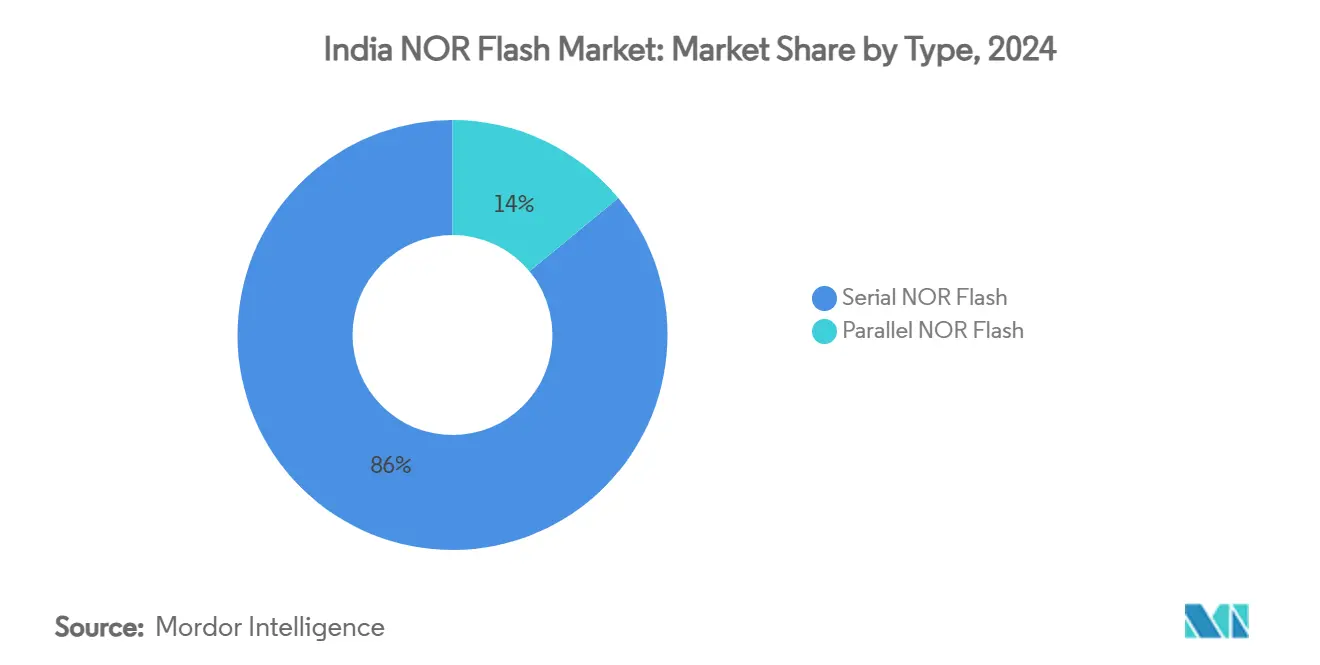
By Interface: SPI Single / Dual remains core while Octal and xSPI accelerates
In 2024, Quad SPI accounted for 55% of India's NOR flash market, primarily due to its compatibility with dominant microcontroller pinouts, debugger toolchains, and legacy boot code. Furthermore, this interface offers deterministic latency without necessitating significant PCB redesigns, which is particularly advantageous for cost-sensitive consumer products. On the other hand, Octal and xSPI are projected to grow at a 7.14% CAGR through 2030, as the increasing adoption of graphics-intensive infotainment systems and AIoT gateways drives the demand for sustained read bandwidth exceeding 400 MBps. This growth is expected to significantly influence the India NOR flash market by expanding its application scope and enhancing its technological capabilities.
Over the forecast period, platform architects are anticipated to transition to protocol-agnostic PHYs, which can seamlessly negotiate among xSPI, HyperBus, and OPI standards. This shift is likely to simplify firmware maintenance and accelerate time-to-market for multiple product SKUs. Additionally, Indian EMS providers have already reported a twofold increase in Octal-ready controller bookings for 2026 builds, indicating a growing preference for advanced technologies. Vendors that integrate protocol-flexible NOR and managed NAND in system-in-package formats are expected to further enhance their average selling price and consolidate their market share, thereby contributing to the overall growth and competitiveness of the India NOR flash market.
By Density: Mid-range 32 Mbit leads while greater than or equal to 256 Mbit surges
In 2024, the 32 Mbit density bracket accounted for 24% of India's NOR flash market share, primarily due to its ability to balance die cost and firmware capacity effectively. This density range has become a preferred choice for applications such as entry-level smartphones, set-top boxes, and cordless power tools. However, the demand for higher densities is increasing, as next-generation dashboard domain controllers and camera fusion modules require ≥256 Mbit to store neural network weights and redundant software partitions. Consequently, this top-end category is projected to grow at a robust 7.21% CAGR, the fastest among all density ranges, thereby significantly influencing the market dynamics.
Furthermore, manufacturers are enhancing cost efficiency by transitioning ≥256 Mbit devices to 28 nm nodes, which increases the number of bits per wafer. Nevertheless, this technological advancement introduces challenges, such as thinner gate oxides that compromise data retention. To address this issue, suppliers are incorporating adaptive ECC schemes. Companies that optimize retention models to withstand India's high-humidity field conditions are expected to secure a competitive advantage in the market. Additionally, the expanding rollout of 5G fixed-wireless networks, which require preloaded carrier-specific firmware, is further driving demand. This development is expected to enlarge the attainable unit pool, thereby positively impacting the India NOR flash market.
By Voltage Class: 3 V devices dominate; 1.8 V grows with battery IoT
In 2024, devices rated at 3 V captured a dominant 63% market share, which highlights their established presence in industrial gateways, programmable logic controllers, and inverter drives. This dominance is attributed to the advantage of maintaining the same voltage rail, which not only avoids costly redesigns but also preserves critical field reliability data. In contrast, 1.8 V devices are expected to grow at a compound annual growth rate (CAGR) of 7.09%, driven by the increasing demand for improved battery life in sensor nodes, wearables, and smart-meter modules. The lower core voltage of these devices reduces active-mode power consumption and extends data-retention intervals during deep sleep, aligning with India’s draft IoT standby-energy code.
Furthermore, suppliers are differentiating their 1.8 V portfolios by incorporating features such as deep-power-down currents below 5 µA, floating-bus current monitors, and advanced solder reflow tolerances designed for compact consumer boards. Companies like Winbond and GigaDevice have introduced 1.8 V product families with integrated authentication engines, combining energy efficiency with enhanced security compliance. As municipal utilities implement nationwide smart-meter projects under the Revamped Distribution Sector Scheme, the attach rate of 1.8 V Quad-SPI devices is anticipated to increase significantly. This trend is expected to strengthen the position of 1.8 V devices in the India NOR Flash Market, as these devices cater to the growing demand for energy-efficient and secure solutions in the region.
By End-user Application: Consumer electronics anchor demand; automotive rises fastest
In 2024, consumer electronics accounted for 35% of total revenue, primarily driven by the expansive assembly lines for smartphones, tablets, and smart TVs located in Noida, Chennai, and Pune. These high-volume EMS factories, which utilize panelized PCBs and standard NOR footprints, ensure consistent weekly pull volumes, irrespective of the seasonal cycles of handsets. Furthermore, the expansion in firmware sizes for mobile-payment tokenization and multi-camera algorithms has resulted in an increase in average density. Consequently, this shift has elevated the bill-of-materials value while avoiding abrupt cost fluctuations, thereby contributing positively to the India NOR Flash Market.
In the automotive sector, applications supported by a 7.22% CAGR in ADAS ECU content are witnessing significant growth. Notably, infotainment, telematics, and safety controllers require cold-start capabilities in under two seconds, which has reinforced NOR as the preferred instant-on storage solution. Moreover, a forthcoming regulatory framework aligned with UNECE R156 is expected to mandate secure and fail-safe OTA updates across the domestic vehicle fleet. This regulatory development is anticipated to establish a secular growth channel for the India NOR Flash Market, diversifying its application base and reducing dependency on handset cyclicality.
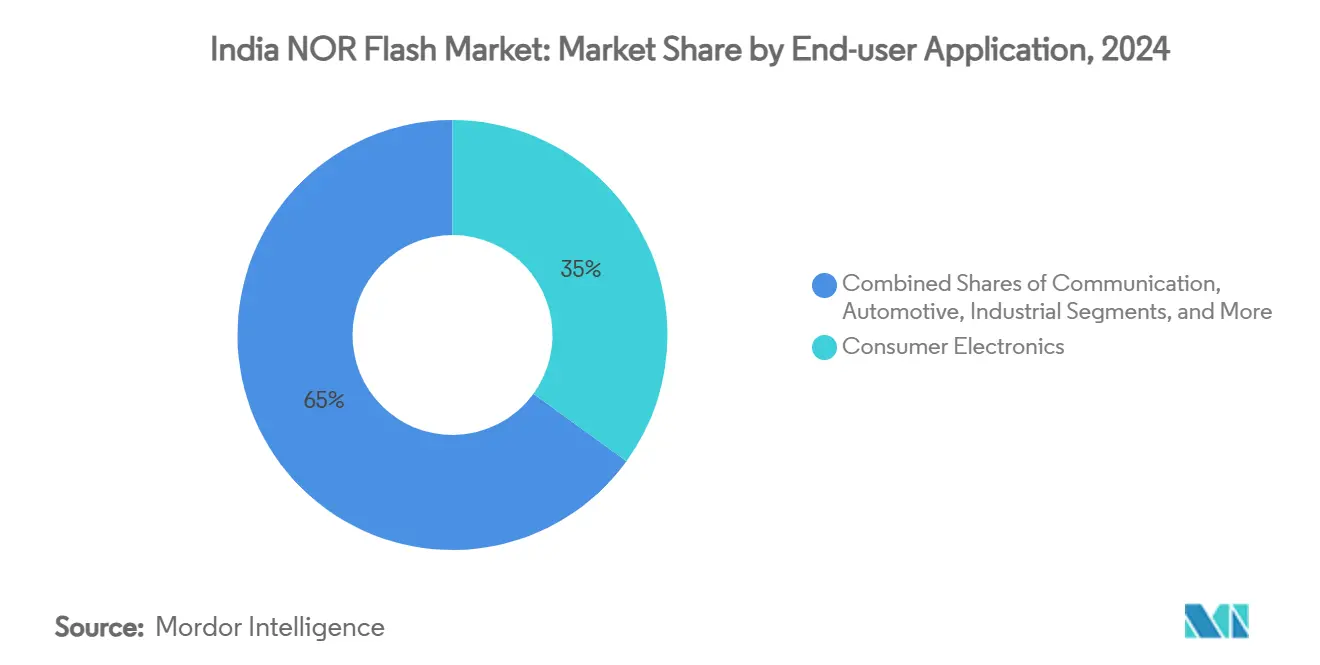
Note: Segment shares of all individual segments available upon report purchase
By Process Technology Node: Mature Nodes Anchor the Build-Up
In 2024, the 65 nm node accounted for 32% of total revenue, primarily due to its reliable yields for 64-256 Mb devices, achieved without the need for EUV exposure. Furthermore, domestic fabs are able to scale up to the 65 nm node with relatively fewer capital expenditure challenges. This development aligns seamlessly with the government's 50% fiscal support initiative, thereby fostering growth in the India NOR Flash Market. Conversely, the segment of 28 nm and smaller is experiencing a robust growth rate of 7.12% CAGR. This growth is driven by the tighter lithography required for Octal components operating above 300 MHz, which is expected to further enhance the technological capabilities and competitiveness of the India NOR Flash Market.
By Packaging Type: WLCSP Leadership Reflects Miniaturization
By package type, QFN/SOIC accounted for a 47.1% share, whereas WLCSP/CSP is poised for growth, driven by a 7.11% CAGR. Furthermore, this trend is expected to accelerate as local ATMP houses, such as Micron's Sanand plant, enhance their fine-pitch bumping capacity [2]Source: Micron Technology, “Micron inaugurates Sanand ATMP campus,” micron.com. This development is anticipated to significantly impact the India NOR Flash Market by fostering advancements in packaging technologies, thereby supporting the growing demand for compact and efficient memory solutions.
In addition, QFN/SOIC packages continue to dominate in industrial drive controllers, particularly in applications where automated optical inspection is essential. Moreover, BGA/FBGA packages cater to multi-gigabit automotive imagers, emphasizing superior electrical performance. Additionally, specialty packages address the requirements of aerospace boards with conformal coatings, where vibration resilience is prioritized over size. These advancements collectively contribute to the evolution of the India NOR Flash Market by enabling the integration of advanced packaging solutions across various applications.
Geography Analysis
In Southern India, Tamil Nadu and Karnataka lead the way, hosting a dense network of outsourced semiconductor assembly and test facilities, PCB fabricators, and passive-component distributors. These entities collectively play a pivotal role in supporting the supply chains for handsets and IoT devices. Furthermore, the proximity of these facilities to the Chennai port facilitates streamlined inbound logistics for wafer lots and test consumables. Additionally, the availability of a skilled labor base ensures uninterrupted 24/7 operations, even during peak festival seasons[3]Source: Investment Promotion and Facilitation Agency, “Indian Electronics Industry Presentation,” ibef.org. As Micron's Gujarat facility scales to full capacity, shipping lanes from Tuticorin to Mundra are expected to handle increased intra-country die transfers. This development is anticipated to reduce transit costs and enhance cost competitiveness, thereby strengthening the India NOR Flash Market [4]Source: Government of Gujarat, “State subsidy scheme for semiconductor projects,” gujarat.gov.in.
In Northern India, regions such as Noida and Greater Noida dominate smartphone assembly operations. These areas leverage existing flat-panel display and battery-cell production lines to achieve procurement synergies. Moreover, EMS providers in this region utilize bonded warehouses, which enable weekly call-offs, thereby maintaining lean inventory levels and optimizing working capital. Duty-free procurement from Sahasra’s QFN-focused line in Rajasthan further mitigates GST leakage. Simultaneously, compliance with secure-boot mandates is driving the adoption of 144 Mbit secure SPI parts as a baseline. This evolving dynamic is broadening regional demand and embedding additional resilience into the India NOR Flash Market.
Competitive Landscape
First-tier suppliers Micron, Infineon, and Winbond command roughly 60% of domestic revenue, leveraging comprehensive device families and early engagement with India’s semiconductor capacity-building schemes. Micron’s backend line in Gujarat, inaugurated in late 2024, bills customers in rupees and offers sub-four-week delivery, a combination that lowers working-capital strain for EMS buyers. Infineon secured design wins with its ASIL-D-certified SEMPER series in ADAS applications, whereas Winbond deepened channel penetration by signing dedicated stocking agreements with two tier-one distributors. Collectively, these moves tighten customer lock-in and consolidate share in the India NOR flash market. Twelve domestic design houses received grants to tape out 22-65 nm NOR controllers and security IP blocks, lowering the barrier to entry for fabless startups [5]Source: Ministry of Electronics and IT, “IoT Security Sandbox Guidelines,” meity.gov.in.
Second-tier competitors in India focus on niche segments such as industrial operating ranges, wide-voltage support, and ultra-long data retention tailored for energy-meter deployments. Flexible wafer sourcing from Indian foundries enables these firms to migrate rapidly to sub-28 nm nodes once volume runs justify mask costs. Domestic design service partners collaborate with second-tier vendors to localize reference designs, thereby embedding them more deeply into the Indian NOR flash market without requiring significant fixed investments.
Emerging local players within India concentrate on assembly and system-level integration rather than wafer fabrication. Their optimized production lines cater to quick-turn Serial NOR orders from IoT startups, while leveraging synergies across sectors such as automotive and defense to bundle NOR, sensors, and microcontrollers under unified procurement contracts.
This collaboration allows global incumbents to secure dependable domestic test capacity, mitigate geopolitical risks, and maintain relevance in the evolving Indian NOR flash market. Consequently, these developments contribute to strengthening the resilience and self-reliance of India's semiconductor supply chain.
India NOR Flash Industry Leaders
-
Micron Technology Inc.
-
Winbond Electronics Corp.
-
Macronix International Co. Ltd.
-
GigaDevice Semiconductor Inc.
-
Infineon Technologies AG
- *Disclaimer: Major Players sorted in no particular order
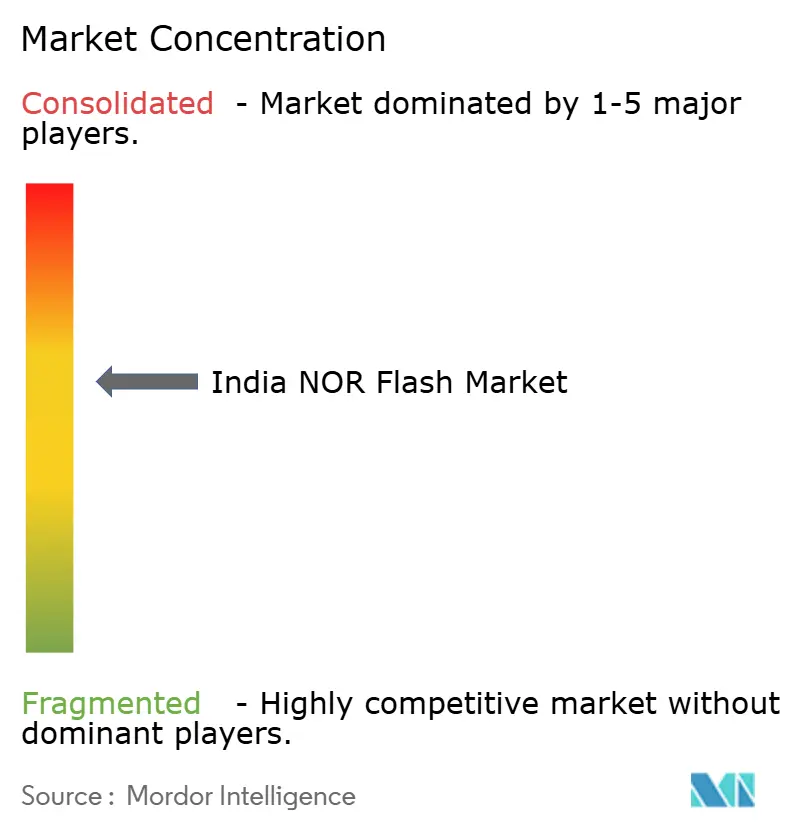
Recent Industry Developments
- May 2025: Infineon Technologies AG announced that its SEMPER NOR Flash family achieved ASIL-D certification, a milestone that strengthens its positioning in functional-safety-critical automotive domains. The strategy underscores Infineon’s intent to widen engagement with Tier-1 suppliers focused on ADAS firmware redundancy.
- May 2025: Renesas Electronics signed a collaboration agreement with the Indian government to foster semiconductor innovation through startups and industry-academia partnerships. This initiative aims to strengthen India's semiconductor ecosystem by developing local talent and innovation capabilities, potentially accelerating the development of domestic NOR Flash design and production expertise
- November 2024: Infineon Technologies delivered the industry's first radiation-hardened-by-design 512 Mbit QSPI NOR Flash for space and extreme environment applications. This technological advancement, developed in collaboration with the U.S. Air Force Research Laboratory, demonstrates Infineon's leadership in specialized NOR Flash applications and could eventually benefit other high-reliability segments in the Indian market Infineon Technologies AG.
- June 2024: Tamil Nadu introduced an enhanced semiconductor policy offering additional state-level subsidies for approved projects, competing with Gujarat for semiconductor investments while attracting companies like Pegatron and Qualcomm for manufacturing and design operations.
Research Methodology Framework and Report Scope
Market Definitions and Key Coverage
Our study defines the India NOR flash memory market as the annual revenue earned from brand-new serial and parallel NOR flash integrated circuits that are designed into consumer electronics, communication gear, automobiles, and industrial controllers. Only chips that are shipped into India or produced domestically and then sold to first-fit board assemblers are counted; aftermarket resales are outside scope.
Scope exclusion: devices based on NAND flash, DRAM, removable cards, and second-hand components are excluded.
Segmentation Overview
- By Type (Value, Volume)
- Serial NOR Flash
- Parallel NOR Flash
- By Interface (Value)
- SPI Single / Dual
- Quad SPI
- Octal and xSPI
- By Density (Value)
- 2 Megabit And Less NOR
- 4 Megabit And Less-NOR (greater than 2mb) NOR
- 8 Megabit And Less (greater than 4mb) NOR
- 16 Megabit And Less (greater than 8mb) NOR
- 32 Megabit And Less (greater than 16mb) NOR
- 64 Megabit And Less (greater than 32mb) NOR
- 128 Megabit and Less (greater than 64MB) NOR
- 256 Megabit and Less (greater than 128MB) NOR
- Greater than 256 Megabit
- By Voltage (Value)
- 3 V Class
- 1.8 V Class
- Wide-Voltage (1.65 V 3.6 V)
- Others - 1.2V Class (and similar sub-1.8V) (2.5V, 5V, etc.)
- By End-user Application (Value, Volume)
- Consumer Electronics
- Communication
- Automotive
- Industrial
- Other Applications
- By Process Technology Node (Value)
- 90 nm and Older
- 65 nm
- 55 nm (including 58 nm)
- 45 nm
- 28 nm and Below
- By Packaging Type (Value)
- WLCSP / CSP
- QFN / SOIC
- BGA / FBGA
- Others
Detailed Research Methodology and Data Validation
Primary Research
Mordor analysts interviewed memory controllers' design leads, contract manufacturers in Noida and Bengaluru, distributors that serve Tier-1 handset OEMs, and procurement heads at automotive ECU makers. Conversations across western, northern, and southern clusters validated density preferences, average selling prices, and forecast adoption of Octal SPI parts, filling gaps that desk work left.
Desk Research
We began with ministry datasets and tariff books (DGFT schedule 854232) that track byte-addressable memory imports, then reviewed Directorate General of Commercial Intelligence & Statistics shipment values, and the MeitY production-linked-incentive filings that disclose local output. Public trade association dashboards from the India Cellular & Electronics Association and SIAM helped us gauge handset and vehicle controller demand. Wider context was drawn from semiconductor outlook notes issued by the Semiconductor Industry Association, patent activity retrieved via Questel, and company 10-K filings. These examples illustrate the tier-one, non-paywalled and paid databases we tapped; many additional sources informed granular checks.
Market-Sizing & Forecasting
A top-down reconstruction that aligns import plus domestic production values with average device price points produced the 2025 baseline. Results were cross-checked through bottom-up supplier roll-ups for five leading vendors, giving us confidence to adjust for grey-market leakage. Key variables include handset PCB shipments, small-cell base-station roll-outs, density mix shifts toward ≥256 Mbit parts, automotive ECU counts, and the rupee-denominated ASP contraction curve. A multivariate regression blended with an ARIMA overlay projects each driver to 2030; scenario analysis tests currency and policy shocks before the model is frozen. Where supplier disclosures were incomplete, calibrated ratios from primary interviews bridged gaps.
Data Validation & Update Cycle
Every model pass is stress-tested against WSTS memory indices and monthly customs tallies. Senior reviewers rerun anomaly filters, and any variance above three percentage points triggers re-contact of domain experts. Reports refresh once a year, with interim patches after material events such as policy tweaks or fabs coming online.
Why Mordor's India NOR Flash Baseline Commands Confidence
Published numbers often differ because researchers pick dissimilar geographies, broader memory mixes, or optimistic price trajectories. Our disciplined scoping and annual refresh cadence temper those swings.
Key gap drivers include competitor studies that merge NAND and NOR, rely on extrapolated global ratios without import reconciliation, or apply single-point ASP declines.
Benchmark comparison
| Market Size | Anonymized source | Primary gap driver |
|---|---|---|
| USD 85.15 million (2025) | Mordor Intelligence | - |
| USD 35 billion; Asia-Pacific flash memory (2024) | Regional Consultancy A | Combines NAND & NOR across 14 countries; no customs validation |
| USD 4.2 billion; global NOR flash (2022) | Trade Journal B | Global scope, older year, relies on vendor press releases without density split |
Taken together, the comparison shows that Mordor's narrowly defined, India-only baseline, grounded in traceable shipment data and cross-examined with industry interviews, offers decision-makers a balanced figure they can reliably build plans upon.
Key Questions Answered in the Report
What is the current value of the India NOR flash market?
The market stands at USD 85.15 million in 2025 and is forecast to reach USD 119.48 million by 2030.
Which product type commands the largest share?
Serial NOR Flash dominates with 86% revenue share in 2024 and is projected to expand at a 7.1% CAGR.
Why is Octal and xSPI gaining traction?
Bandwidth-intensive systems such as in-vehicle infotainment require faster boot and data-read speeds, driving a 7.14% CAGR for Octal and xSPI devices.
How do government incentives influence growth?
PLI and Semicon India subsidies cover up to 50% of assembly-line capital costs, trimming landed prices and adding roughly 3.2 percentage points to the market’s CAGR.
Which end-user sector is growing quickest?
Automotive electronics leads with a 7.22% CAGR in ADAS ECU content, making it the fastest-expanding application segment.
What challenges could slow the market?
The lack of domestic sub-55 nm wafer fabrication and duties that add up to 14% to average selling prices remain key restraints on the India NOR flash market.
Page last updated on:
